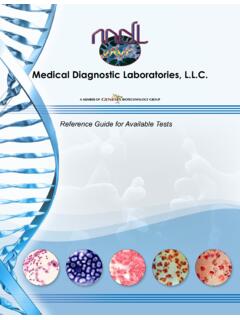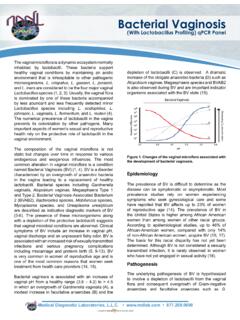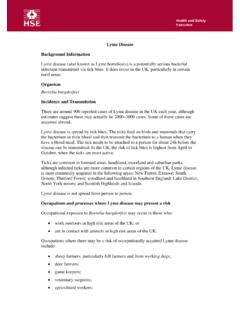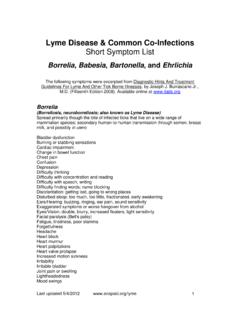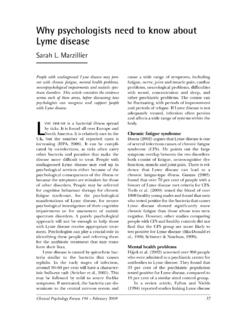Transcription of MEDICAL DIAGNOSTIC LABORATORIES, L.L.C.
1 Lyme DiseaseMEDICAL DIAGNOSTIC LABORATORIES, 877 269 0090 IntroductIonEarly in the 20th century, European physicians observed patients with a red, slowly expanding rash called erythema migrans (EM) (Figure 1) (1). They associated this rash with the bite of ticks and postulated that EM was caused by a tick-borne bacterium. In the 1940s, a similar tick-borne illness was described that often began with EM and developed into a multi-system illness. In 1969, a physician in Wisconsin diagnosed a patient with EM and successfully treated the individual with penicillin. In 1975, a women in Old Lyme, Connecticut contacted the state health authorities to ask why so many children in her town had arthritis.
2 She was alarmed by the fact that 12 cases of juvenile arthritis, a relatively rare disease, had been diagnosed in a town with a population of only 5,000. Subsequent investigations of these and similar cases led to the discovery of Lyme disease and to the identification of the causative disease (LD), caused by infection with Borrelia burgdorferi, is the most common vector-borne disease in the United States, accounting for more than 95% of all reported vector-borne illnesses. From 2003-2005, 64,382 cases of Lyme disease were reported to the CDC from 46 states and the District of Columbia (2). However, a considerable level of underreporting is associated with Lyme Disease and, therefore, the true number of infected individuals is probably greater.
3 Of the reported cases, 59,770 occurred within ten endemic states: Connecticut, Delaware, Maine, Maryland, Minnesota, New Jersey, New York, Pennsylvania, Rhode Island and Wisconsin (2). Within these endemic states, the average annual rate of infection over this three year period was cases per 100,000 population (2). Three counties, New York s Columbia and Dutchess counties and Massachusetts Dukes County, were determined to have an incidence rate of 300 cases per 100,000 population (2). Evaluation of race and sex revealed a slightly higher incidence for males (54% of reported cases) and that 97% of the cases affect caucasians (2). Persons of all ages and both genders are equally susceptible, although the highest incidence of LD occurs in children ages 0-14 years and in persons 30 years of age and older (median, 28 years).
4 LD has been reported in 49 states and the District of Columbia. Lyme borreliosis also occurs in temperate regions of the Northern Hemisphere in Europe (3), Scandinavia (4), the former Soviet Union (5), China (6) and Japan (7). In the United States, the infection is spreading and has caused focal epidemics, particularly in the northeastern United States (8-10). From 1985 to 1989, the number of counties in New York State with documented I. scapularis ticks increased from 4 to 22, and the number of counties endemic to LD increased from 4 to 8 (11). During the subsequent 10 years, I. scapularis ticks have spread to 54 of the 62 counties in the state. In the US, the majority of affected individuals have had symptoms of the illness, whereas in Europe, the majority is asymptomatic (10, 11).
5 Of 346 people who were studied in the highly endemic area of Liso, Sweden, 41 (12%) had symptoms of the illness and 89 (26%) had evidence of subclinical infection (12). In a serosurvey of 950 Swiss orienteers, 26% had detectable IgG antibodies to B. burgdorferi, but only 2% to 3% had a past history of definite or probable LD (Figure 2) (1,13).Figure 1: Erythema migrans rash in Lyme 1982, spirochetes were identified in the midgut of the black-legged, adult deer tick, Ixodes scapularis, and given the name Borrelia burgdorferi. Finally, conclusive evidence that B. burgdorferi caused Lyme disease came in 1984 when spirochetes were cultured from the blood of patients with the rash EM and from the cerebrospinal fluid of a patient with meningoencephalitis and history of prior EM.
6 The Centers for Disease Control and Prevention (CDC) began surveillance for Lyme disease in 1982. The Council of State and Territorial Epidemiologists (CSTE) designated Lyme disease as a nationally notifiable disease in January BIoLoGY Ticks evolved 94 million years ago from mites as parasites of reptiles, birds, and mammals. More than 50 species of ticks can feed on humans (13, 14). Ticks belong to two taxonomic families, the soft ticks (Argasidae) and the hard ticks (Ixodidae). Humans are not the principal, but rather the serendipitous host for most ticks (Figure 3) (1).Attachment: Upon finding a suitable host, the tick raises its body at an angle to the skin surface and the chelicerae begin to cut the epidermis (17).
7 Mouthpart lengths differ significantly, with lengths in Dermacentor (dog ticks) extending to the dermis-epidermis interface, while the mouthparts of Ixodes species extend well into the dermis (18).cement: Salivary glands of Ixodid ticks generally secrete an attachment cement, which is believed to serve as an adhesive and to seal the bite lesion bridging the cleft between mouthparts and host tissue (19). Attachment cement secretion begins within minutes after skin penetration and hardens into a tube surrounding the mouthparts. Mechanics: Cutting action and mouthpart insertion produces an expanding hemorrhagic pool within the tissues, which is aided by anticoagulants, vasodilators, and platelet aggregation inhibitors in tick saliva (17).
8 Mouthpart mechanical actions alone are not sufficient to account for the lesion. The lesion is characterized by a large blood-filled cavity. Ixodid tick blood feeding is not continuous (17). The first few days of hard tick feeding are referred to as the slow feeding phase, which coincides with cuticle growth to accommodate the blood meal. Next, the rapid feeding phase is characterized by the uptake of very large quantities of blood. The increase in size during the 7 to 10 day slow-feeding phase can be 10-fold, with an additional 10-fold increase during the rapid-feeding phase (20). This increase actually underestimates the amount the blood consumed, since fluid from the blood meal is reintroduced into the host during salivation (20).
9 Figure 2: Approximate geographic distributions of I. ovatus (green with horizontal lines), I. pacificus (red with horizontal lines), I. persulcatus (red), I. ricinus (green), I. scapularis (blue), R. evertsi (yellow with horizontal lines), and R. pumilio (yellow with vertical lines).Figure 3: (A) Adult female lone star tick (Ameblyoma americanum). The lone star tick is broadly distributed throughout the southeastern quadrant of the United States, with ranges extending into New England and the Midwestern states. All three life cycle stages of A. americanum can bite humans. A. americanum is a recognized vector of several pathogens that cause diseases in humans, including ehrlichioses caused by E.
10 Chaffeensis and E. ewingii, and has been implicated as a vector of southern tick-associated rash illness believed to be caused by Borrelia lonestari. Other pathogens or potential pathogens have also been detected in this tick, including various spotted fever group rickettsiae, Francisella tularensis, and Coxiella burnetti, although the role of A. americanum in the transmission of these agents to humans is not well characterized. (B) Adult female American dog tick (Dermacentor variabilis). This tick is abundant in the southeastern United States and coastal New England, with limited distribution in several midwestern states, southern Canada, and western coastal regions.

